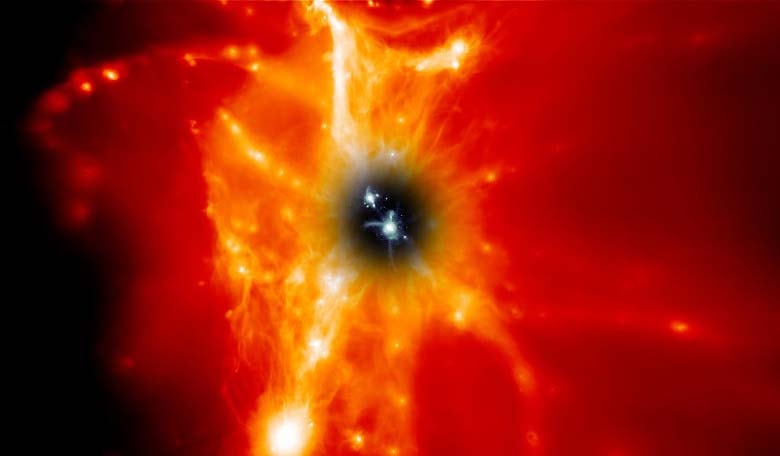When it comes to recycling, heavy elements should be top of the list for galactic re-use in star and planet formation, however in a new study led by the University of Colorado Boulder, researchers have discovered that galaxies are in fact very wasteful and most of the material needed to build new stars is ejected up to a million light years away.
Using the Cosmic Origin Spectrograph (COS) installed on NASA's Hubble Space Telescope, the study shows that more iron, carbon and oxygen atoms exist in the near-invisible reservoir of gas that surrounds a galaxy, known as the circumgalactic medium (CGM) – regions that can span millions of light years – than exist within the galaxies themselves. Galaxies are therefore deprived of a rich source of raw materials needed to build stars and planets.
These extensive, gaseous halos of gas and dust surrounding galaxies are thought to play a central role in cycling elements in and out of a galaxy, but exactly how this process works still remains elusive. "Previously, we thought that these heavier elements would be recycled in to future generations of stars and contribute to building planetary systems," said Benjamin Oppenheimer, a research associate in the Center for Astrophysics & Space Astronomy (CASA) at CU-Boulder and lead author of the study. "As it turns out, galaxies aren't very good at recycling."
To aid with the study, the team ran simulations on two types of galaxies that were then targeted with COS, which uses ultraviolet spectroscopy to study the evolution of the universe: spiral galaxies that have a blueish colour and like the Milky Way actively form stars, along with elliptical galaxies that appear red but also have little star formation. Nonetheless, despite the disparity in the galaxies star-producing ability, the simulations by the team revealed that both types of galaxy are not as efficient at retaining their raw materials as previously thought, as half of their heavier elements were found in their respective CGM.
"The remarkable similarity of the galaxies in our simulations to those targeted by the COS team enables us to interpret the observations with greater confidence," said Robert Crain, a Royal Society University Research Fellow at Liverpool John Moores University and a co-author of the study.
In addition, the new simulations also helped to explain why there appears to be a shortfall in oxygen around elliptical rather than spiral galaxies, as highlighted by puzzling COS observations. "The CGM of the elliptical galaxies is hotter," said Joop Schaye, a professor at Leiden University in the Netherlands and a co-author of the study. "The high temperatures, topping over one million degrees Kelvin, reduce the fraction of the oxygen that is five times ionized, which is the ion observed by COS."
The CGM gas in spiral galaxies on the other hand reaches temperatures that are around fifty times hotter than the surface of the Sun – approximately 300,000 degrees Kelvin. To populate a galaxies CGM with heavy elements it takes massive amounts of energy from supermassive black holes and exploding supernovae in violent and long-lasting processes that can take over 10 billion years, “which means that in a galaxy like the Milky Way, this highly ionized oxygen we're observing has been there since before the Sun was born,” said Oppenheimer.











